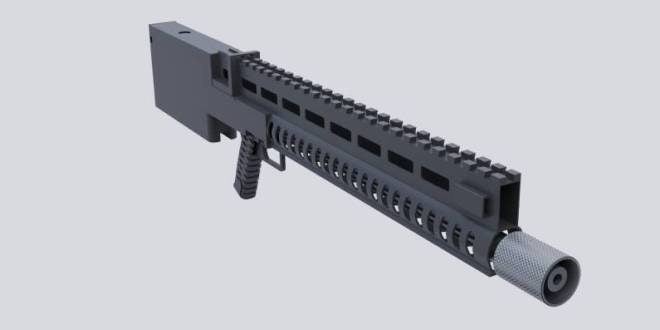When checking the news feed in Russian and former Soviet countries’ websites, I came across an article written in a Russian website called Voyennoye Obozreniye about a new rifle concept called VAR (Vasilyev Automatic Rifle). At first glance, it was one of those concepts that makes you think “someone plays video games too much”. However, by learning more about it, I found that the designer (Andrey Vasilyev) is quite a knowledgeable man and his concept does have some legit solutions. It was clear for me – I need to present this to our readers!
Thanks to this great age of Internet, it was a matter of several minutes to find Andrey on social media websites, contact him and ask permission to use the content (images, videos) for writing an article about his concept gun for the English-speaking audience. He kindly granted me that permission.
In his article, Andrey points out several challenges that small arms design has faced and seems to be incapable of offering viable solutions to. He notes that modern body armor is really ahead of small arms developments. Anything including and weaker than the 7.62x51mm NATO or 7.62x54mmR rounds are less effective and sometimes completely useless against modern high-level body armor. Another point is that within the past 50 years or more all attempts of improving the infantry weapons and ammunition largely were failures despite being promising on paper. That concepts include the delayed recoil impulse guns, balanced action firearms, flechette, polymer-cased and caseless ammunition. Andrey also criticizes the currently deployed systems such as the gas operated and delayed blowback systems. He says that gas operation is too violent involving many impact points during the cycling of the action and preventing to have a true free floated barrel. He also states that fluted chambers are necessary for the proper operation of delayed blowback firearms but such chambers are also the weak links of these systems because they are prone to be clogged up with carbon residues during extensive exploitation.
Vasilyev considers that improving a single part on the firearm or a single ammunition component won’t give a solution to the modern challenges. What he offers is a complex solution that would include designing new weapons and ammunition that would meet the modern combat needs by being reliable, capable of penetrating the currently used body armor and those that may be deployed in the foreseeable future as well as making it possible to have a high rate of fire and stability of the weapon system. In other words, he claims that a new cartridge-projectile-weapon system must be developed and that’s what he is attempting to do by presenting the VAR weapon system. He also thinks that the new weapon must be capable to be deployed as an assault rifle, LMG and DMR thus being a universal solution for all infantry small arms needs in the modern battlefield.
Let’s discuss the ammunition first then go through the design features of the Vasilyev Automatic Rifle.
9.3x40mm SPEAR Ammunition Concept
One of the key components of the Vasilyev Automatic Rifle concept is its ammunition. Vasilyev considers that in order to reliably penetrate the modern body armor, you need high-velocity subcaliber projectiles made of tungsten alloy. As you know, tungsten is a very dense material and will provide sufficient mass to his bullet design that represents a long conical saboted projectile. He calls this ammunition 9.3x40mm SPEAR.
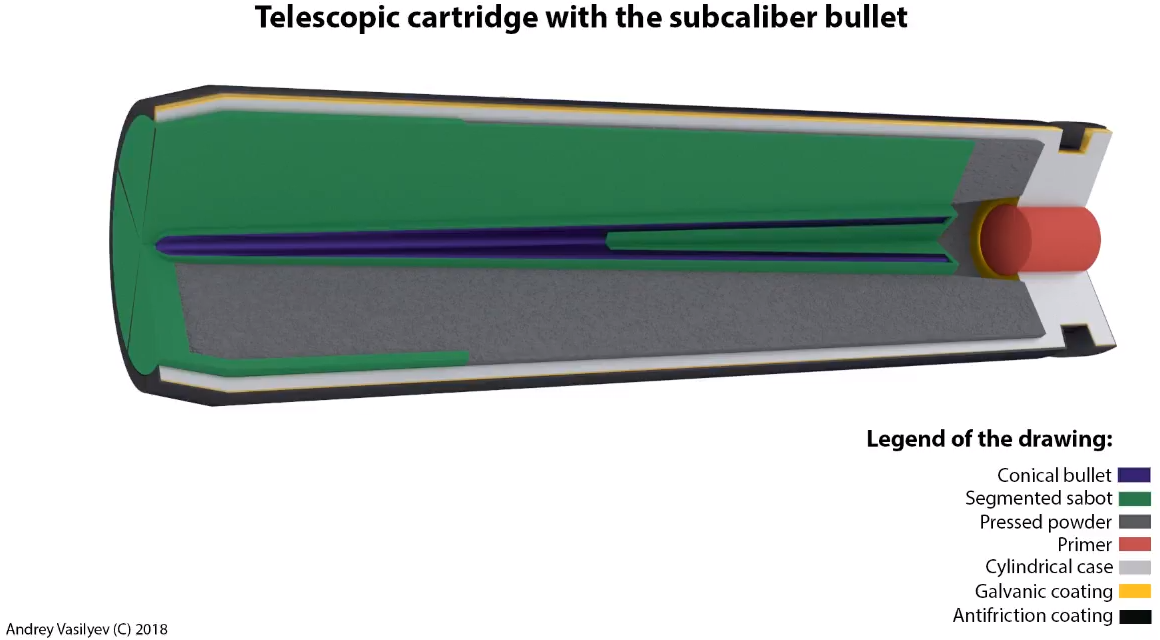
As you can see in the above-embedded image, the SPEAR projectile also has a cavity in its tail portion. According to the designer, although there will be spin imparted to the bullet and sabot, the tail cavity will give it an additional drag stabilization capability. The hollow tail is also supposed to deform after penetrating the armor thus increasing the bullet’s diameter and making it yaw in tissue hence being more effective after penetrating the body armor. He considers this design superior to the flechette concepts because of the lack of fins and driving bands. According to Andrey, such projectile will have about 1.5 times more muzzle velocity than the bullet of the 5.45x39mm cartridge. It is calculated to have a muzzle velocity of 1,360 m/s (4.462 fps) and muzzle energy of 1,664 Joules (1,228 ft-lb). The SPEAR projectile is designed to weigh 1.8 grams (28 grains) and the sabot is estimated to weigh 0.8 grams (12 grains).
I think that it is an interesting design, however, it must be made and extensively tested to see if the projectile that looks good in theory will work as expected in the real world. The cost of tungsten is also an issue that I think maybe a hard obstacle in the way of fielding such ammunition.
Another interesting design feature of this ammunition is that it is supposed to be used in Lancaster type oval bore rifling which according to the designer will provide less bore wear due to the lack of distinct lands and grooves. Andrey also claims that Lancaster rifling will reduce the friction between the barrel and projectile thus increasing the barrel life. Along with the polymer sabot, such rifling should decrease the barrel heating rate and be capable of handling higher pressures and higher rates of fire.
As seen in the images and in the above-embedded video, the SPEAR ammunition is cased and telescoped. The case has a slight shoulder at its mouth which should be the headspacing point. The designer considers polymer cased and caseless ammunition to have multiple drawbacks such as being fragile and prone to cook-offs. That’s why he considers the use of aluminum alloy as a case material to be optimal in terms of reliability and weight savings. The aluminum case is supposed to be lacquer coated over copper coating to provide high lubricity, prevent the aluminum oxidation and minimize the heat transfer and friction inside the chamber.
The telescoping case is obviously designed to provide a space for a relatively long projectile without increasing the overall length of the cartridge. The SPEAR cartridge is expected to weigh 7.4 grams (about 114 grains) thus being about 1.5 times lighter than the 5.45x39mm cartridge. It means that the soldiers can carry that much more ammunition at a given weight (considering that the packing density is similar). Another feature of the SPEAR case is its rebated rim. If the case diameter is 10mm, the rim diameter is 8mm. The rebated rim design is chosen to work with the mechanism of the gun which we’ll get to in a moment. The propellant for this ammunition should be a compressed double-base powder with chemical additives to provide burn rates similar to that of the currently used loose powders.
Vasilyev Automatic Rifle Design and Layout
In order to meet the above-described requirements of being an assault rifle, DMR and LMG, the weapon has to have a long barrel. That being said, the bullpup design is the solution to keep the overall length of the system reasonable for all the applications. The single piece chassis combines the handguard, shoulder stock, and the magazine compartment. It also includes a vertical recoil lug insert.

The free-floated barrel is screwed into the receiver. It has an integral muzzle brake and a provision for a flash hider attachment. There is no quick barrel change capability incorporated into this design concept. The barrel is also designed to have a fluted profile. It must have a nitrided finish/surface treatment. The rear portion of the barrel includes the curved surfaces that work as a guide for the feeding mechanism. We’ll discuss that in the next subheading.
I think ideally, the integrated muzzle devices can also be used as a suppressor host. I assume a special suppressor must be designed for this weapon system that would work with the saboted projectile. You can’t have a conventional suppressor design, because the sabot sections may separate inside the can and cause malfunctions or obstructions in the way of next projectiles. Probably an integral suppressor or a design similar to shotgun suppressors where the saboted projectile is traveling in a perforated tube will allow eliminating these issues.
The receiver along with the bolt carrier group are designed to be made of steel with an NP3 coating. This assembly is inserted into the chassis from its rear portion. The receiver houses the parts of the mechanism of operation as well as the barrel nut. The rear portion of the receiver forms the buttplate.
The magazine design and location are somewhat similar to HK G11 magazines. The double stack single feed magazine is designed to be located over and along the barrel, in a compartment separated from the barrel channel. The designer considers this to be an optimal solution for a high capacity magazine because drum magazines are too bulky and it is very hard to make a reliably functioning quad stack magazine. The cartridges in Vasilyev Automatic Rifle magazine are facing up (when the magazine is inserted) thus exposing the case head to the feeding mechanism. The magazine capacity is estimated to be 90 rounds. The loaded weight of the magazine should be 900 grams (32 oz). The designer claims that each soldier can easily carry 10 loaded magazines thus having 900 rounds of ammunition.
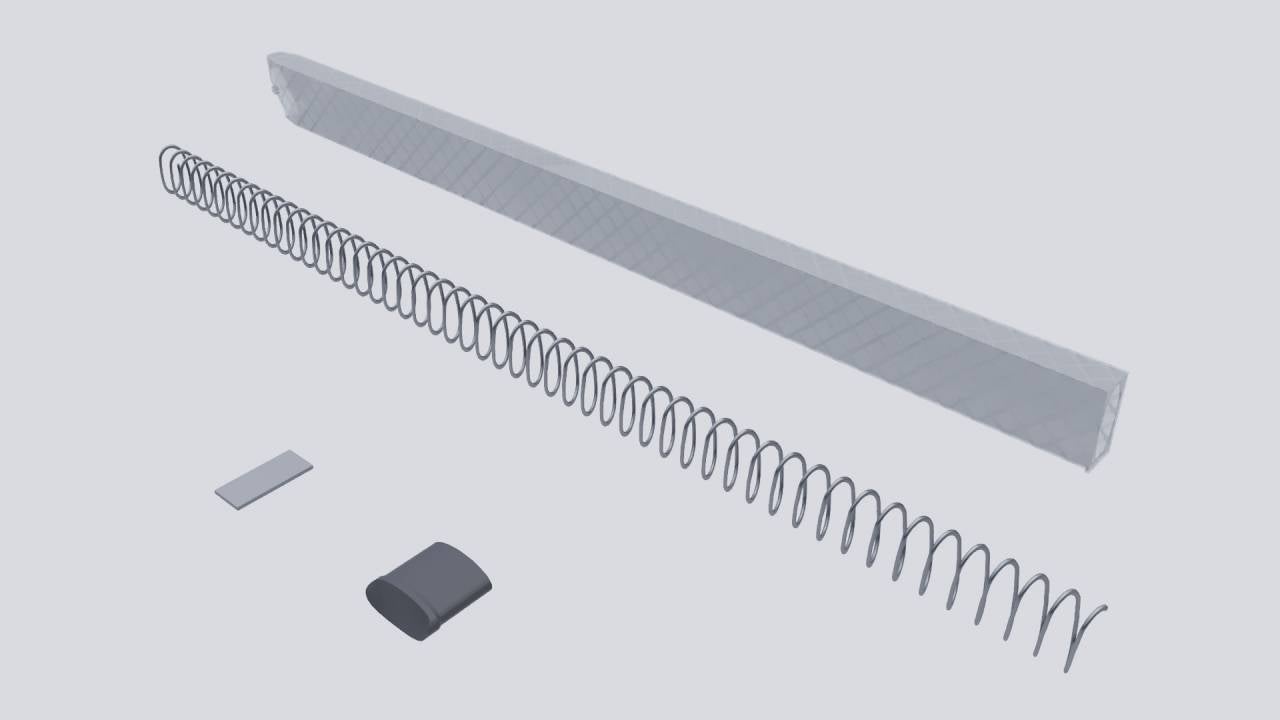
The magazine compartment protects the magazine from damage and has cutouts on its sides to allow visual identification of the remaining ammunition in the magazine. The latter is made of a translucent material. This compartment should be tight enough to allow secure housing for the magazine but at the same time loose enough to have room for dust and debris that could otherwise interfere with the magazine insertion and removal processes. The magazine is inserted from the front of the compartment. I think that should be a bit awkward process to do in the field. Probably, designing an FN P90 style insertion mechanism could make the magazine manipulations more comfortable.
The magazine compartment also has a built-in spring that should help to remove the magazine and I assume it will also apply tension to the inserted magazine ensuring a consistent alignment in the gun. The Vasilyev Automatic Rifle rifle has a downward ejection pattern which makes it ambidextrous and comfortable to shoot from any position and from either shoulder.
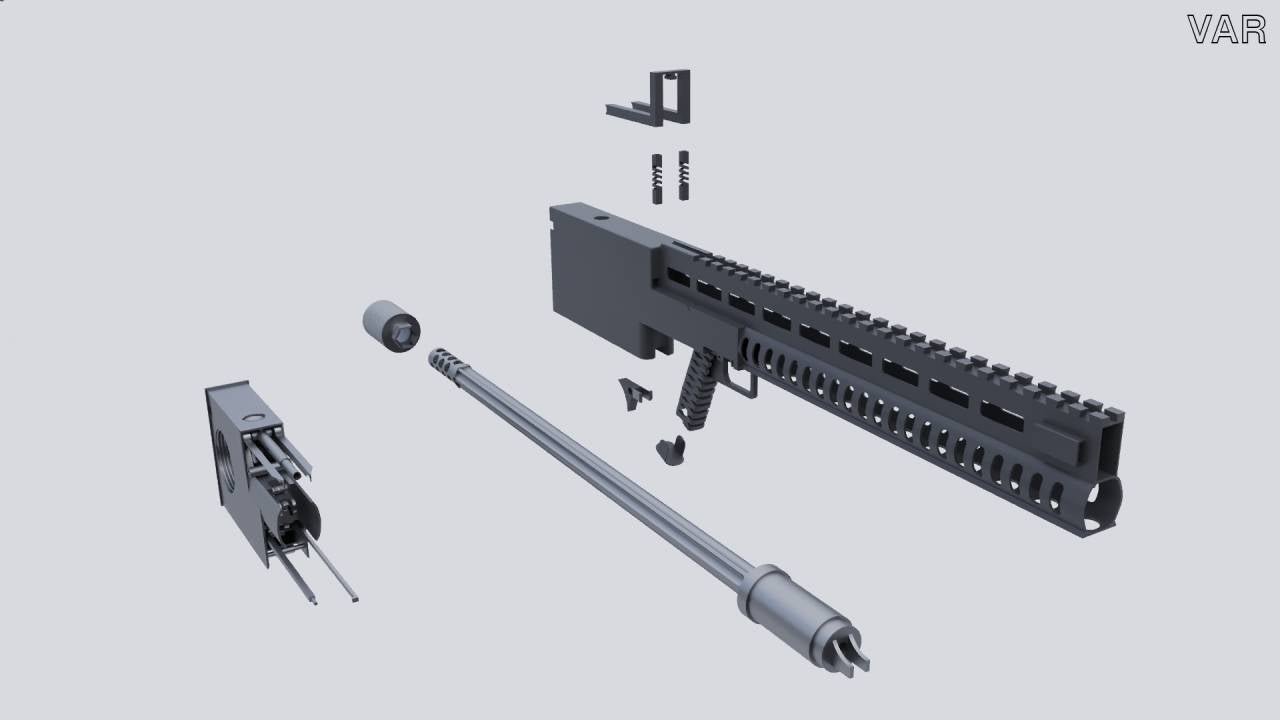
Vasilyev Automatic Rifle is a hammer fired firearm. The sliding safety selector is located above the trigger guard. On the single shot mode, the rifle fires from a closed bolt and the burst fire (three round bursts) is accomplished from an open bolt to make the barrel cool faster and eliminate the possibility of a cook-off. Interestingly, there is no full auto mode. The Vasilyev Automatic Rifle concept is also designed to have a cleaning kit and a bore snake located inside the grip. The rifle has a non-reciprocating charging handle and no bolt stop mechanism.
The overall length of this rifle is estimated to be 860mm (34″) with a barrel length of 600mm (about 24″). The sight radius must be 510mm (20″). The width of the weapon is 44mm (about 1-3/4″). The overall weight is calculated to be 3.4 kilograms (7.5 lbs).
Mechanism of Operation
Andrey Vasilyev has designed a delayed blowback mechanism for his rifle which he partially borrowed from an early experimental Soviet aircraft machine gun (YuAS (ЮАС) machine gun designed by Yuriy Yurchenko). It consists of two assemblies of slider-crank mechanisms located on either side of the bolt. The bolt also follows the case into the chamber to increase the time from the cartridge being fired to the case being exposed from the chamber. That is why the case has a rebated rim. This solution reminds me of the Oerlikon autocannon.
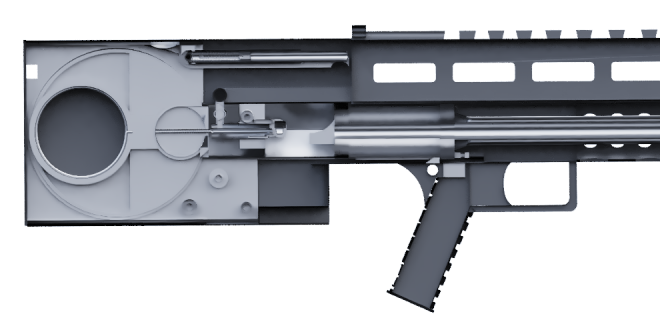
The feeding of the action is accomplished by a separate feeding part that upon closing the bolt hits the curved surface of the barrel extension, slides upwards and hooks onto the cartridge rim. Upon rearward motion of the bolt, the feeder strips the round from the magazine and aligns it to the bolt face which then feeds the round into the chamber. The animation of the feeding mechanism is shown in the video embedded below.
The system of crank discs has the counterweights and return springs built into them. Such a system is supposed to eliminate any impact of the moving parts onto the receiver or chassis. It is also designed to be sort of a variation of a balanced action mechanism because the two crank mechanisms are designed to rotate in opposite directions. Theoretically, these features will make the weapon much more controllable. High controllability and extremely high rates of fire (2000 rpm at three-round burst mode) should make the system very accurate with a high rate of hit probability and devastating downrange performance.
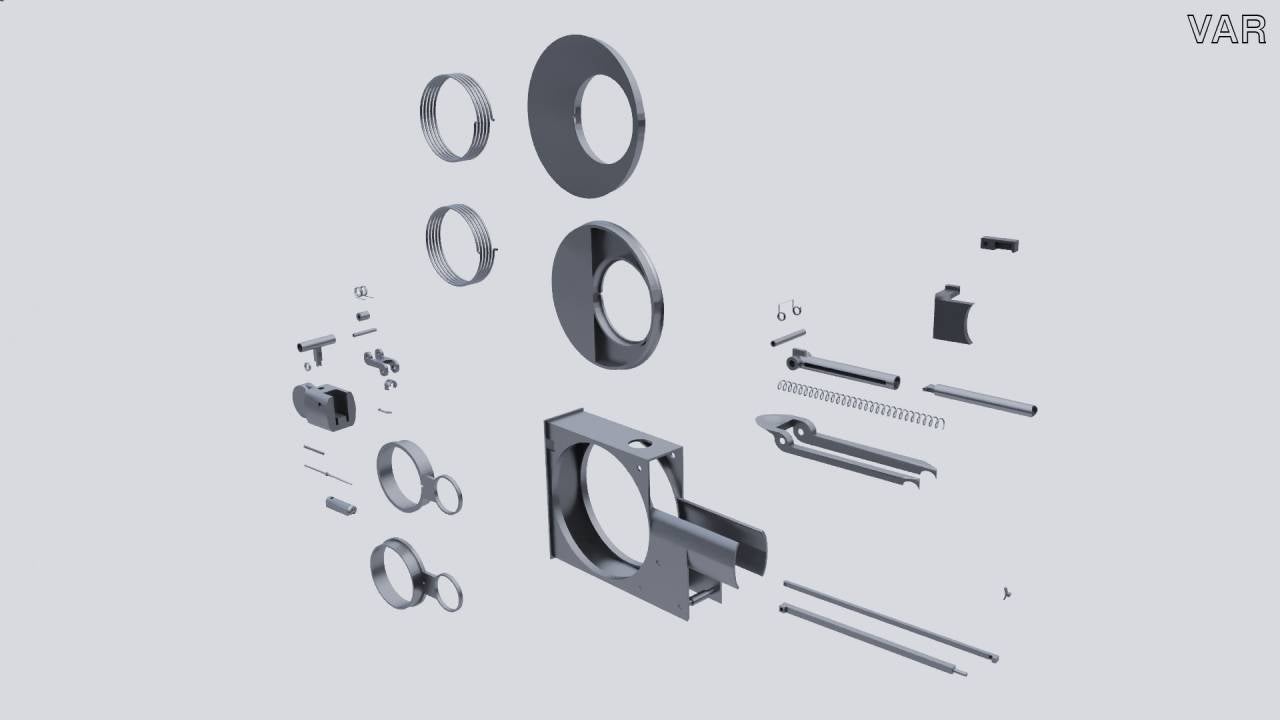
I think that Vasilyev Automatic Rifle concept has some really interesting design solutions and combinations thereof. I am sure, that in order to prove the viability of the concept there is no other way than making a prototype. What do you think about the Vasilyev Automatic RIfle?
Sources:
Vasilyev A. (2018, September 26). “Стрелковый комплекс пуля-патрон-оружие”. Voyennoye Obozreniye. Retrieved from: https://topwar.ru/147480-strelkovyj-kompleks-pulja-patron-oruzhie.html
Images by Andrey Vasilyev
 Your Privacy Choices
Your Privacy Choices
